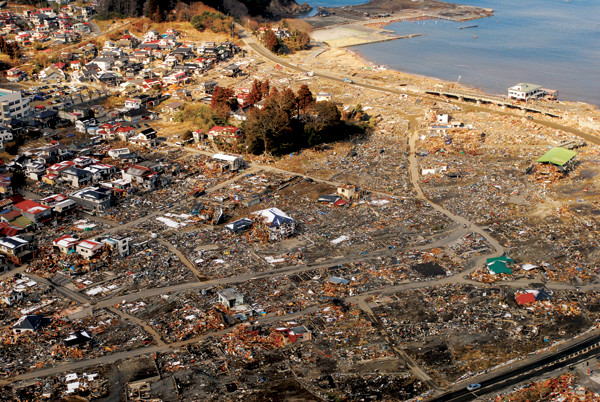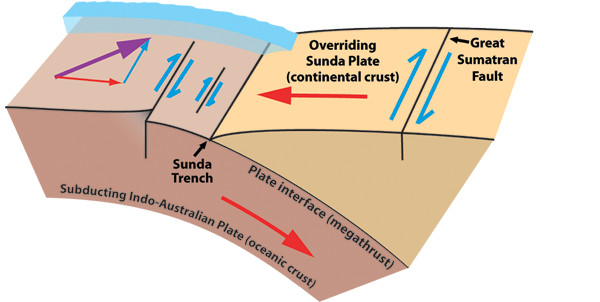
by Timothy Oleson Friday, March 15, 2013

Heavy damage was sustained on the Japanese coast, as seen here in Sukuiso, following the magnitude-9 Tohoku earthquake in March 2011. During the quake, a rupture might have been triggered on a slow-moving part of the nearby megathrust fault by heating and pressurization of fluids within the fault. U.S. Navy photo by Mass Communication Specialist 3rd Class Dylan McCord

The oceanic Indo-Australian Plate moves diagonally (purple arrow) with respect to the Sunda Megathrust, subducting beneath the overriding Sunda Plate at an oblique angle. Some of the motion associated with the subduction is oriented perpendicular (red arrows) to the trench, meaning that stress accumulates on the plate interface and occasionally results in megathrust earthquakes. But there is also motion of the Indo-Australian Plate in the direction parallel to the trench (thin blue arrow), resulting in an accumulation of stress on strike-slip faults (oppositely oriented blue arrows) either on the overriding plate — as in the Great Sumatran Fault — or on the oceanic plate. AGI, after Ishii et al., Geology, 2013
If rules are made to be broken, then perhaps conventional wisdom is made to be overturned. The spate of large earthquakes in recent years — the magnitude and location of which have defied scientific expectations in several cases — has provided ample support for these maxims, at least within earth science. For all the confusion, though, data emerging from these events are reshaping and improving our understanding of how faults operate.
In one recent study, researchers re-examined a longstanding notion about which parts of a fault are capable of rupturing. “Previously, people just assumed that faults can be classified into two parts, or two characteristic behaviors,” says Hiroyuki Noda, a geophysicist at the Japan Agency for Marine-Earth Science and Technology. The first is the typical stick-slip behavior associated with earthquakes, in which a locked portion of a fault accumulates stress until it breaks. The second behavior, known as creeping, is characterized by slow, stable motion on a fault that gradually releases pent up tectonic pressure.
Many factors control which behavior prevails on a given fault section, including the rate at which pressure is accumulating on it, the type of rock present, and temperature. In general, though, creeping sections were thought to be immune from earthquakes and to actually act as barriers to stick-slip behavior, in effect limiting the propagation and size of earthquake ruptures.
But like many earthquake scientists, Noda and his colleague Nadia Lapusta at Caltech observed that during the magnitude-9 Tohoku earthquake in Japan in March 2011, the largest amount of slip on the megathrust fault occurred on a relatively shallow portion of the fault that was thought to be creeping and that was far from where the rupture started. A similar pattern was seen with the magnitude-7.6 Chi-Chi earthquake that ruptured on the Chelungpu Fault and rocked Taiwan in 1999. Motivated by these seemingly anomalous observations, Noda and Lapusta developed a model to simulate the interaction between locked and creeping fault sections.
To improve the model’s accuracy, they based parameter values controlling frictional and hydraulic properties of the different fault sections on values that had been measured experimentally by other researchers using rock collected from drill cores through the Chelungpu Fault. Noda and Lapusta ran the model over the course of several thousand simulated years using realistic rates of tectonic loading and found that earthquakes in the model were always initiated on the locked portion of the fault, as expected. Contrary to conventional wisdom, however, these earthquakes could sometimes trigger the creeping portion of the fault to rupture, thereby substantially increasing the overall magnitude of the event.
Based on their results and on differences in the permeability of the rock taken from different portions of the Chelungpu Fault, the researchers suggested that a process called thermal pressurization may be a crucial mechanism by which this triggering can happen. When an earthquake occurs, it can induce a small amount of slip — and, thus, friction — on the surrounding rock, including the part of the fault that is creeping. The friction heats the rock along with any fluids contained in pore spaces. If the rock is permeable, the heated fluids can flow away from the fault, relieving pressure. But if the rock has low permeability — as in the case of the sample taken from the creeping portion of the Chelungpu — the “fluid pressure increases and tries to push against the normal stress [holding the fault in place] and decrease the frictional resistance,” Noda says. If it pushes hard enough, then the creeping portion ruptures as well, compounding the energy released from the initial earthquake.
The long-term earthquake record produced by the model matched well with the actual record on the Chelungpu Fault, and it also accurately reproduced specific observations from single events such as the Chi-Chi earthquake, the researchers reported in Nature. “Our results clearly imply that fault behavior is much more complex than what people have assumed,” Noda says. The findings offer insights into why quakes like the 2011 Japan event may have been so much bigger than scientists had expected, he and Lapusta wrote.
The idea that thermal pressurization can weaken faults during earthquakes is not new, but what Noda and Lapusta have done that’s unique “is put that together with the Taiwan drill hole observations … into a single simulation that seems to reproduce a variety of observations,” says Kaj Johnson, a geophysicist at Indiana University who was not involved in the study.
More fieldwork and laboratory work is needed “to constrain these kinds of numerical simulations,” Johnson says, but this study “definitely throws a wrench into the traditional view” of faults. “There is no reason to think that [thermal pressurization is] a condition that’s special to northern Japan or Taiwan,” he says, adding that if creeping faults can rupture, then hazard assessments may need to be revisited for places like the San Andreas Fault, which hosts “one of the most famous examples of a creeping fault section” between its northern and southern locked portions.
Noda and Johnson each point out that just because a creeping fault section may be capable of rupturing doesn’t mean it will rupture. “It depends on many things,” Noda says, adding that there are still many more aspects of faults and friction left to decipher.
Another new study has helped shed light on one such mystery: why two huge strike-slip earthquakes occurred far off the Sumatran coast in April 2012. The larger of the two earthquakes — with a magnitude of 8.6, it was the biggest strike-slip event ever recorded — dashed scientists’ notions about the maximum size of such quakes. The quakes also left researchers wondering if they were related to the nascent, diffuse plate boundary tearing the Indo-Australian Plate — on which the peculiar quakes occurred — in two, or to subduction on the nearby Sunda Megathrust. “It was so large. And … it was in a place that we really didn’t think that these events would occur,” says Miaki Ishii, a seismologist at Harvard University and lead author of the study in Geology. “There were a lot of scientific questions we wanted to answer.”
Ishii and her team used a wealth of recorded seismic data and tsunami wave readings to reconstruct the complex sequence of ruptures involved in the earthquakes. In contrast to earlier analyses that suggested a more north-south orientation, they found that the composite sequence actually had a predominantly northwest-southeast orientation, parallel to the megathrust.
The reason for the orientation, the researchers suggested, is that the oceanic Indo-Australian Plate is subducting beneath the overriding Sunda Plate at an oblique angle. Thus, while some of the stress associated with the subduction is accumulated on the interface between the two plates — resulting in occasional megathrust events like the magnitude-9.1 Sumatra earthquake in 2004 that set off the Indian Ocean tsunami — some of it is also accumulated within the plates parallel to the fault.
Scientists have “typically thought that the trench-parallel component is taken up on [strike-slip faults on] land on the overriding plate side,” Ishii says, for example, on the Great Sumatran Fault that runs the length of Sumatra. Many such faults, including the Great Sumatran, show so-called slip deficits, “meaning that the expected amount of slip hasn’t happened yet” and implying that the faults could be overdue for big ruptures. However, in this case at least, Ishii and her colleagues suggested that the missing slip may have been accommodated in the oceanic plate, resulting in the anomalously large quakes last April.
Ishii says that if you think of the larger of those earthquakes as an isolated event, then based on conventional understanding of strike-slip faults, “8.6 is way too large.” However, if the Indo-Australian Plate was accommodating the slip deficit from the Great Sumatran Fault and the quake was a response to the oblique subduction on the megathrust, then, she says, “the size turns out to be not that surprising, considering that we probably haven’t had this sort of event for a long time.”
It’s unclear yet whether the earthquakes ruptured along existing faults or if new faults were ripped open in the ocean crust. If it were the latter, it could help explain the large magnitude, Ishii says. “If you’ve [newly] ruptured through a tough, hard material, you’re releasing more stress than if you’re having an earthquake on a well-established plane fault.” Either way, if researchers find that the process of stress being taken up on the subducting oceanic plate is common among oblique subduction zones, including Sumatra and southwestern Japan, for example, then “the hazard on the landside fault is going to be a lot smaller.” That would be good news for people living near those faults, Ishii says.\
© 2008-2021. All rights reserved. Any copying, redistribution or retransmission of any of the contents of this service without the expressed written permission of the American Geosciences Institute is expressly prohibited. Click here for all copyright requests.